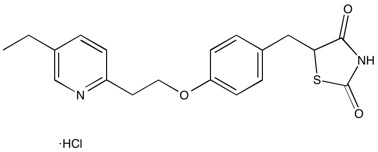Pioglitazone HCl | PPAR gamma agonist
NMR (Conforms)

Available Options
| Size: | Price | Quantity | |
|---|---|---|---|
| 10 mg | $30.00 | ||
| 50 mg | $100.00 |
Pioglitazone (112529-15-4) is a clinically useful antidiabetic drug.1 It is a selective agonist of the human peroxisome proliferator-activated receptor γ 1 (PPARγ1; EC50 = 490 nM2, 550 nM3) with weak agonist activity at PPARα and no activity at PPARδ.2 Inhibits mitochondrial pyruvate metabolism and glucose production in hepatocytes.4 Suppresses production of inflammatory cytokines and shows antidepressant-like activity in mouse models.5
References/Citations:
1) Merck 14:7452
2) Sakamoto et al. (2000), Activation of human peroxisome proliferator-activated receptor (PPAR) subtypes by pioglitazone; Biochem. Biophys. Res. Commun., 278 704
3) Wilson et al. (2000), The PPARs: From Orphan Receptors to Drug Discovery; J. Med. Chem., 43 527
4) Shannon et al. (2017), Pioglitazone Inhibits Mitochondrial Pyruvate Metabolism and Glucose Production in Hepatocytes; FEBS J., 284 451
5) Zhao et al. (2016), The Antidepressant-Like Effects of Pioglitazone in a Chronic Mild Stress Mouse Model Are Associated With PPARγ-Mediated Alteration of Microglial Activation Phenotypes; Neuroinflamm., 13 259
NMR (Conforms)
Safety Data Sheet:
Product Data Sheet:
Materials provided by Focus Biomolecules are for laboratory research use only and are not intended for human or veterinary applications. Please note that we do not sell to individuals and that all orders placed by non-research organizations will incur a $20 restocking/refund fee
Pioglitazone (112529-15-4) is a clinically useful antidiabetic drug.1 It is a selective agonist of the human peroxisome proliferator-activated receptor γ 1 (PPARγ1; EC50 = 490 nM2, 550 nM3) with weak agonist activity at PPARα and no activity at PPARδ.2 Inhibits mitochondrial pyruvate metabolism and glucose production in hepatocytes.4 Suppresses production of inflammatory cytokines and shows antidepressant-like activity in mouse models.5
References/Citations:
1) Merck 14:7452
2) Sakamoto et al. (2000), Activation of human peroxisome proliferator-activated receptor (PPAR) subtypes by pioglitazone; Biochem. Biophys. Res. Commun., 278 704
3) Wilson et al. (2000), The PPARs: From Orphan Receptors to Drug Discovery; J. Med. Chem., 43 527
4) Shannon et al. (2017), Pioglitazone Inhibits Mitochondrial Pyruvate Metabolism and Glucose Production in Hepatocytes; FEBS J., 284 451
5) Zhao et al. (2016), The Antidepressant-Like Effects of Pioglitazone in a Chronic Mild Stress Mouse Model Are Associated With PPARγ-Mediated Alteration of Microglial Activation Phenotypes; Neuroinflamm., 13 259
Calculate the molar concentration, mass or volume in a solution.
Concentration × Volume × Molecular Weight = Mass
Focus Biomolecules • Plymouth Meeting, PA USA • 1-855-FOCUS21
Focus Biomolecules
Plymouth Meeting, PA USA
1-855-FOCUS21
Website Created by Advanta Advertising LLC.

